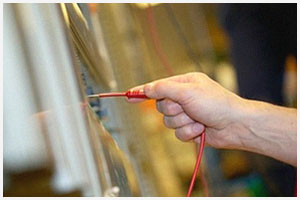
Lightning rods, originally developed by US scientist Benjamin Franklin in 1749, are widely used to protect buildings built against lightning strikes today. The physical structure consists of a pointed metal attached to the end of a rod, as we see on the tops of buildings. The rod is connected to a conductive grid embedded in the ground by an aluminum or copper cable, independent of the electrical transmission lines of the structures.
The purpose of lightning protection systems is to protect a building's electrical installation, including electronic devices and its inhabitants, against direct lightning. In order to discharge the lightning, the energy must pass through the ground in a safe way.
Lightning strikes select the transmission line where lightning rods are installed, which is a very low resistance way to discharge in areas where lightning rods are present. In this way, high currents flow into the ground without damaging the systems in the building.
In order to obtain the expected benefit from lightning rods, it must be checked by qualified persons at least once a year. This obligation is stated in the Regulation on Health and Safety in the Use of Work Equipment issued by the Ministry of Labor and Social Security.
Radioactive lightning rods, active lightning rods and lightning rods with varieties such as Faraday cage are frequently used in many buildings, houses, factories, towers and even spacecraft launching ramps. Generally, lightning protection installation and grounding installation are controlled together. Radioactive lightning rod signal test is done with a radiation measurement tool. Different tests are applied for active lightning rods according to their type. However, the title test is definitely done.
In addition, physical controls are performed for both lightning rod types. The lightning conductor grounding system resistances are measured and compared with the required criteria. Lightning protection systems are installed in accordance with the project prepared according to the lightning risk report. For this reason, the inspectors want to see the lightning risk report of the building before the inspection.
For more information, please contact our specialists at our contact addresses or telephone numbers.